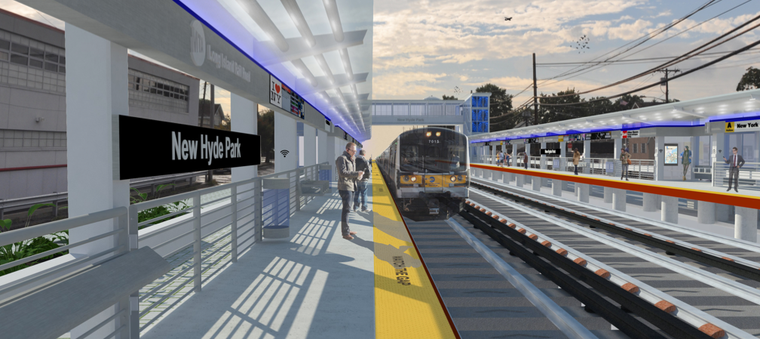The environmental study of the Long Island Rail Road’s proposed third track project is not up to snuff under the state’s environmental review law, a lawyer representing four municipalities contended in a letter last week.
In comments he submitted on behalf of the Town of Hempstead and the villages of Floral Park, New Hyde Park and Garden City, Michael G. Murphy, an attorney for the Manhattan environmental law firm Beveridge & Diamond, called the draft environmental impact statement, or DEIS, for the project “largely superficial” and said it omitted specifics that should have been included under state law.
Murphy’s 30-page Feb. 14 letter said the LIRR should restart the environmental review — which took several months — and issue a new study that explains in more concrete terms how the railroad will mitigate negative impacts.
“The DEIS exposes a hasty rush to complete the environmental review process at all costs,” Murphy wrote. “What the public is left with remains vague and largely conceptual in nature.”
Murphy’s letter referred to a technical analysis of the environmental study by the Vertex Companies, a construction engineering firm the villages and town hired to review the LIRR’s $2 billion plan to build a third track on 9.8 miles of its Main Line between Floral Park and Hicksville.
It was sent the day before the end of the public comment period for the environmental impact statement on Feb. 15. The LIRR also collected comments at six public hearings in January.
Planners will now incorporate the comments into a final environmental impact statement to be issued later this year. Project officials have said construction could start as early as 2018 and would take four years to complete.
In the letter, Murphy said the study omits concrete details about the project’s design, and does not thoroughly explain how officials arrived at their time or cost estimates, which he called “wildly optimistic.”
It also understates the project’s potential impacts on local business districts, village tax bases and freight train traffic through the Main Line corridor, Murphy wrote.
That lack of specificity fails to meet the standards of the State Environmental Quality Review Act, or SEQRA, the law governing projects that will have significant impacts on the environment, Murphy argued.
“A new DEIS should be prepared and reissued for public review and comment to ensure that the project’s environmental review complies with SEQRA’s basic requirements,” Murphy wrote.
Murphy’s letter echoes several criticisms that officials living along the project corridor have leveled since Gov. Andrew Cuomo announced the project in January 2016.
The municipalities that hired Beveridge & Diamond are not considering immediate legal action under the environmental review law, but it could be on the table in the future, Thomas Tweedy, the Floral Park mayor, said in an interview.
The Town of Hempstead is paying $25,000 toward Vertex and Beveridge & Diamond’s fees, and the three villages will split the rest of the cost evenly, Tweedy said.
The Village of Mineola, which also lies along the project corridor, had its regular counsel from the Garden City firm Spellman Rice Gibbons Polizzi & Truncale respond to the environmental study, village Clerk Joseph Scalero said.
Project officials rejected the claims in Murphy’s letter, saying the environmental study goes well beyond the state law’s requirements in terms of detail and specificity.
The impact statement contains a construction schedule more detailed than past studies of larger projects, such as the Second Avenue Subway, and states that the Metropolitan Transportation Authority’s Capital Program will be amended to fund the third track, project officials said.
Planners have touted an “unprecedented” public outreach effort that has included meetings with local officials and community leaders, in-person talks with homeowners living near the tracks and a project information booth at the Mineola LIRR station.
Officials have pledged not to take any residential property, and to eliminate all seven street-level railroad crossings along the corridor, build sound barriers, add parking and upgrade stations in response to local feedback, Shams Tarek, a project spokesman, said in a statement.
“This project is a long overdue and rare opportunity to realize so many improvements to the LIRR and local communities,” Tarek said. “It’s not surprising that a report commissioned by a mayor who’s been a longtime opponent of this project would draw certain conclusions. That said, we welcome all public comments and this project will continue to be a reflection of that input, as it has from day one.”
Supporters of the project — including business leaders, transportation advocates and commuters — say a third track is needed to make the railroad system more reliable and provide better service as it expands.
About 40 percent of the LIRR’s daily ridership travels along the Main Line corridor, project documents say. A third track would give trains a way around accidents, preventing delays from rippling throughout the system, officials have said.



